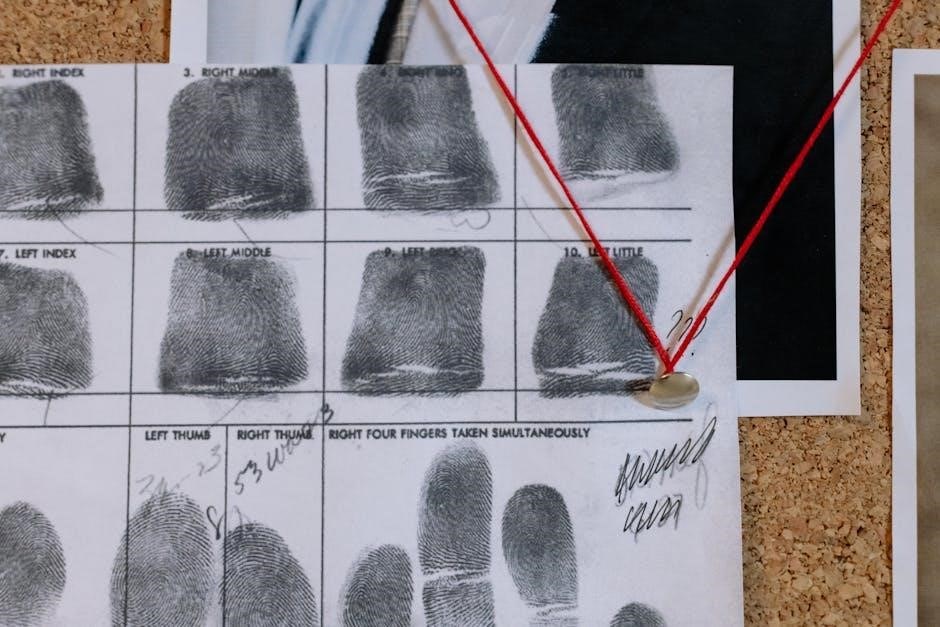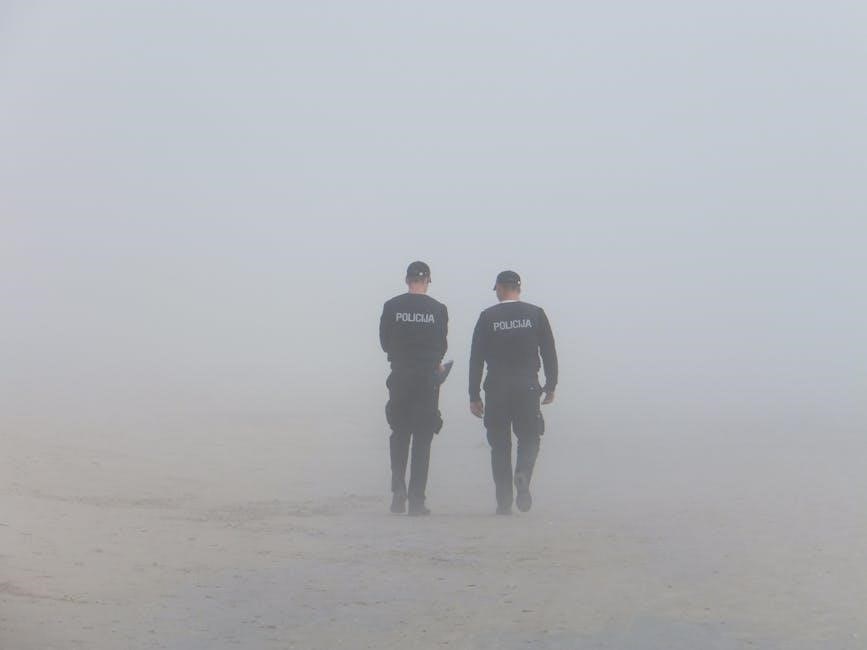
Criminology is the interdisciplinary study of crime, criminal behavior, and the criminal justice system. It examines the causes, consequences, and prevention of crime, shaping justice policies.
1.1. Definition and Scope of Criminology
Criminology is the scientific study of crime, criminal behavior, and the criminal justice system. It explores the causes, nature, and consequences of crime, as well as strategies for prevention and control. Criminology is interdisciplinary, drawing on sociology, psychology, law, and other fields to understand criminality. Its scope includes examining legal frameworks, social influences, and psychological factors that contribute to crime. By analyzing these elements, criminology aims to develop effective policies and practices to address criminal behavior and promote justice. It also focuses on victimology and the impact of crime on individuals and society, making it a vital field for creating safer communities.
1.2. Historical Development of Criminology
Criminology has evolved significantly since its emergence in the 18th century. Early theories, such as Cesare Beccaria’s classical school, emphasized rational choice and deterrence. The 19th century saw the rise of positivist approaches, focusing on biological and environmental factors. In the 20th century, sociological theories like strain theory and labeling theory gained prominence. Modern criminology integrates diverse perspectives, including routine activity theory and evidence-based practices. This historical progression reflects shifting societal views on crime, from punishment to prevention, and underscores criminology’s dynamic nature in addressing contemporary challenges in criminal justice and crime control.
1.3. Importance of Studying Criminology
Studying criminology is crucial for understanding the complexities of crime and justice. It equips individuals with insights into the causes of criminal behavior, enabling effective policy development. Criminology informs strategies for crime prevention, rehabilitation, and victim support. By analyzing the criminal justice system, it promotes fairness and accountability. Professionals in policing, law, and social work benefit from its interdisciplinary approach. Ultimately, criminology contributes to creating safer societies by addressing root causes of crime and improving community well-being. Its relevance extends to global issues, making it a vital field for addressing modern challenges in justice and human rights.

Theories of Crime and Criminal Behavior
Theories of crime explore the biological, psychological, social, and environmental factors driving criminal behavior. They provide frameworks to understand motivations and develop strategies for prevention and intervention.
2.1. Classicist Theory
Classical Theory, rooted in the Enlightenment, posits that crime results from rational choices made by individuals. It emphasizes free will, suggesting people weigh risks and rewards before acting. This perspective, influenced by Cesare Beccaria, advocates for deterrent punishments proportional to crimes. It assumes human behavior is driven by self-interest and that harsh penalties can discourage criminal acts. Unlike positivist theories, classicism focuses on the act rather than the offender, promoting legal clarity and consistency. It underpins modern criminal justice systems, emphasizing deterrence and retribution, though critics argue it oversimplifies human behavior and neglects social contexts.
2.2. Positivist Theory
Positivist Theory emerged in the 19th century, shifting focus from punishment to understanding criminal behavior’s root causes. It emphasizes biological, psychological, and social factors influencing criminality. Cesare Lombroso, a key figure, proposed the “born criminal” concept, linking crime to inherited traits. This theory rejects the idea of free will, instead attributing criminal behavior to factors like mental illness, poverty, or environmental conditions. Positivism advocates for rehabilitation over punishment, aiming to address underlying causes. Modern applications include criminal profiling and tailored interventions. By focusing on empirical research, positivism has shaped criminal justice practices, emphasizing prevention and offender rehabilitation.
2.3. Modern Theories (Routine Activity Theory, etc.)
Modern theories of crime, such as Routine Activity Theory (RAT), focus on the interaction of factors that enable criminal acts. RAT, developed by Cohen and Felson, posits that crime occurs when a motivated offender, a suitable target, and the absence of capable guardianship converge. Other modern theories include Broken Windows Theory, which links disorder to crime, and Rational Choice Theory, which suggests criminals weigh potential benefits and risks. These frameworks emphasize situational and environmental influences, offering practical strategies for crime prevention, such as improving surveillance and community engagement. They provide a dynamic understanding of criminal behavior, adapting to contemporary societal changes.
The Criminal Justice System
The criminal justice system encompasses law enforcement, judiciary, and corrections, aiming to maintain social order, deter crime, and rehabilitate offenders through structured processes and institutions.
3.1. Structure and Components
The criminal justice system is structured into three primary components: law enforcement, judiciary, and corrections. Law enforcement agencies, such as police, are responsible for investigating crimes and arresting suspects. The judiciary, comprising courts and judges, handles trials, determines guilt, and imposes sentences. Corrections involve prisons, probation, and parole services, focusing on offender rehabilitation and reintegration. Each component interacts to maintain order, deliver justice, and ensure public safety. Effective collaboration among these parts is crucial for a fair and efficient system addressing criminal behavior and supporting victims. This structure ensures accountability and rehabilitation within society.
3.2. Law Enforcement
Law enforcement agencies are the frontline responders in the criminal justice system, tasked with maintaining public order and investigating crimes. Police departments and federal agencies like the FBI work to prevent and detect criminal activities. Their roles include arresting suspects, gathering evidence, and ensuring community safety. Effective law enforcement relies on collaboration with the community, often through initiatives like neighborhood patrols and tip lines. Advances in technology, such as surveillance and data analysis, enhance their capabilities. Building trust between law enforcement and the public is critical for reducing crime and fostering cooperation in maintaining justice and security within society.
3.3. The Judiciary
The judiciary plays a pivotal role in the criminal justice system, interpreting laws and ensuring justice is served. Courts, led by judges, conduct trials, hear evidence, and determine guilt or innocence. The judiciary also reviews cases on appeal, correcting potential errors. Judges must remain impartial, balancing legal technicalities with societal expectations. Their decisions impact not only individual cases but also set legal precedents. Effective judicial systems require transparency, fairness, and adherence to the rule of law to maintain public trust and uphold justice, ensuring that the rights of both victims and defendants are protected throughout the legal process.
3.4. Corrections and Rehabilitation
Corrections and rehabilitation are critical components of the criminal justice system, focusing on punishing offenders and preparing them for reintegration into society. Correctional institutions use data to determine security levels, housing, and work assignments for inmates. Rehabilitation programs, such as education, counseling, and vocational training, aim to reduce recidivism by addressing underlying issues like substance abuse or mental health. Despite these efforts, challenges such as overcrowding and limited resources hinder effective rehabilitation. The ultimate goal is to balance punishment with opportunities for personal growth, ensuring offenders can lead productive lives post-release, thereby enhancing public safety and reducing crime rates.
Victimology
Victimology examines the experiences and impacts of crime on victims, focusing on their rights, support, and roles within the criminal justice system, addressing societal factors influencing victimization.
4.1. Scope and Definitions
Victimology, a subset of criminology, focuses on the study of victims, their experiences, and the impact of crime on their lives. It examines the relationship between victims and offenders, societal factors influencing victimization, and the role of victims within the criminal justice system. The scope includes understanding victim rights, support services, and the psychological, emotional, and financial consequences of crime. Victimology also explores victim blaming, vulnerability, and the disparities in victimization rates across different demographics. Its definitions encompass direct and indirect victims, addressing both individual and collective harm; The field aims to advocate for victim rights and improve justice outcomes, ensuring respectful and professional treatment of victims by criminal justice entities. By addressing these aspects, victimology contributes to a more inclusive understanding of crime and its broader societal implications.
4.2. Victimization: Types and Impact
Victimization encompasses the physical, emotional, and financial harm experienced by individuals or groups due to crime. It can be direct, such as physical assault, or indirect, like the emotional trauma faced by victims’ families. The impact extends beyond immediate consequences, often leading to long-term psychological effects, such as anxiety and loss of trust. Victimization also affects communities, fostering fear and destabilizing social cohesion. Additionally, it can result in financial strain and social isolation for victims; Understanding these dynamics is crucial for developing effective support systems and policies to address the multifaceted consequences of victimization and promote recovery and justice for those affected.

Crime Prevention and Control
Crime prevention involves strategies to reduce criminal activity through deterrence, education, and community engagement. Effective prevention addresses root causes like poverty and social inequality, promoting safer societies.
5.1. Strategies for Crime Prevention
Effective crime prevention strategies focus on addressing the root causes of crime and reducing opportunities for criminal behavior. Primary prevention targets societal factors like poverty and inequality through education and community programs. Secondary prevention aims to intervene early in at-risk individuals, such as youths, through mentorship and support. Tertiary prevention focuses on rehabilitating offenders to prevent recidivism. Strategies also include improving urban design, enhancing surveillance, and promoting community policing. By fostering collaboration between law enforcement, policymakers, and the public, these approaches create safer environments and reduce crime rates, ultimately building a more resilient and just society.
5.2. Role of Community in Crime Control
The community plays a vital role in crime control by fostering trust and cooperation with law enforcement. Neighborhood watch programs and public awareness campaigns empower residents to identify and report suspicious activities. Community engagement in crime prevention initiatives helps reduce crime rates and creates a safer environment. Collaborative efforts between local organizations and authorities ensure tailored solutions to specific crime challenges. By addressing underlying issues like unemployment and social inequality, communities can prevent criminal behavior before it occurs. Active participation in crime control not only deters offenders but also strengthens social bonds, reducing fear and enhancing overall well-being.

Rehabilitation and Reintegration
Rehabilitation focuses on transforming offenders into productive members of society through education, counseling, and skill development. Reintegration ensures their successful return to communities, reducing recidivism and fostering social harmony.
6.1. Rehabilitation Programs
Rehabilitation programs aim to equip offenders with skills and support to lead law-abiding lives. These programs include vocational training, mental health counseling, education, and substance abuse treatment. Correctional institutions often use CHRI data to tailor programs to individual needs, focusing on reducing recidivism. Community-based initiatives, such as halfway houses, provide transitional support. Technology, like online learning platforms, enhances access to education and job skills. The goal is to address underlying issues, fostering personal growth and societal reintegration. Effective rehabilitation not only benefits individuals but also contributes to safer communities by reducing crime rates and promoting offender accountability.
6.2. Challenges in Reintegration
Reintegration of offenders into society faces significant challenges, including societal stigma, limited job opportunities, and mental health issues. Many offenders struggle with securing stable housing and employment due to criminal records. Mental health challenges, often exacerbated by incarceration, further hinder successful reintegration. Additionally, inadequate support systems and community skepticism create barriers. Criminal justice bodies must address these challenges collaboratively, ensuring respectful and professional treatment of offenders. Without effective support, recidivism rates remain high, underscoring the need for comprehensive reintegration strategies that foster community acceptance and provide practical assistance.
Criminology provides insights into crime, justice, and rehabilitation, shaping policies and practices. Its interdisciplinary approach remains vital for understanding and addressing criminal behavior, fostering societal well-being.
7.1. Summary of Key Concepts
Criminology is an interdisciplinary field exploring crime, criminal behavior, and justice systems. It integrates theories from sociology, psychology, and law to understand crime’s causes and consequences. Key concepts include crime prevention strategies, victimology, and the role of law enforcement. The criminal justice system’s components—law enforcement, judiciary, and corrections—work together to maintain order. Modern theories like Routine Activity Theory and feminist perspectives expand understanding. Criminology’s practical applications shape policies, rehabilitation programs, and community engagement. By addressing root causes and promoting evidence-based practices, criminology aims to reduce crime and enhance justice, fostering safer societies and equitable outcomes for all individuals involved.
7.2. Future Directions in Criminology

Future directions in criminology emphasize technological advancements, such as AI and big data, to predict and prevent crime. Collaborative efforts between law enforcement, policymakers, and communities will enhance justice systems. A growing focus on victims’ rights and rehabilitation programs will prioritize reintegration and reduce recidivism. Feminist and intersectional perspectives are gaining prominence, addressing gendered and systemic inequalities. Globalization and cybercrime require international cooperation and specialized expertise. By integrating interdisciplinary insights, criminology will evolve to address emerging challenges, ensuring equitable and effective justice systems for diverse populations and fostering safer, inclusive societies.






